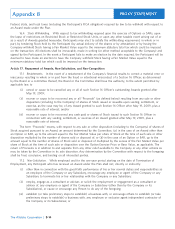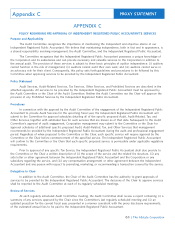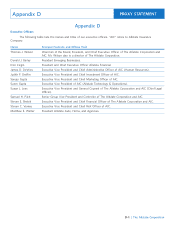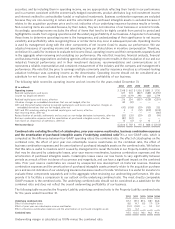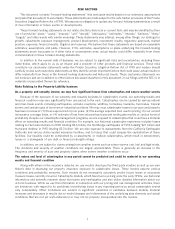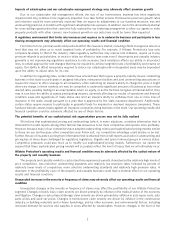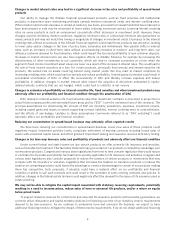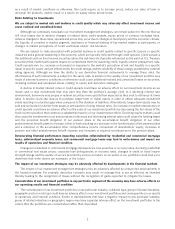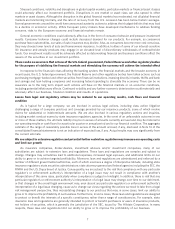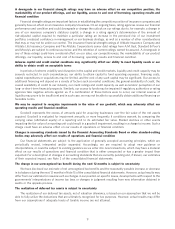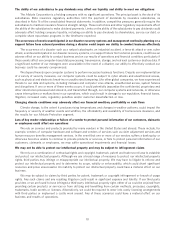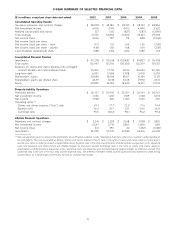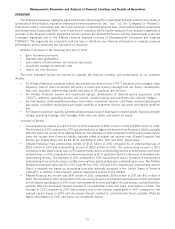Allstate 2013 Annual Report Download - page 118
Download and view the complete annual report
Please find page 118 of the 2013 Allstate annual report below. You can navigate through the pages in the report by either clicking on the pages listed below, or by using the keyword search tool below to find specific information within the annual report.Impacts of catastrophes and our catastrophe management strategy may adversely affect premium growth
Due to our catastrophe risk management efforts, the size of our homeowners business has been negatively
impacted and may continue to be negatively impacted if we take further actions. Homeowners premium growth rates
and retention could be more adversely impacted than we expect by adjustments to our business structure, size and
underwriting practices in markets with significant catastrophe risk exposure. In addition, due to the diminished potential
for cross-selling opportunities that cannot be fully replaced by our brokering arrangement to allow our agents to write
property products with other carriers, new business growth in our auto lines could be lower than expected.
A regulatory environment that limits rate increases and requires us to underwrite business and participate in loss
sharing arrangements may adversely affect our operating results and financial condition
From time to time, political events and positions affect the insurance market, including efforts to suppress rates to a
level that may not allow us to reach targeted levels of profitability. For example, if Allstate Protection’s loss ratio
compares favorably to that of the industry, state regulatory authorities may impose rate rollbacks, require us to pay
premium refunds to policyholders, or resist or delay our efforts to raise rates even if the property and casualty industry
generally is not experiencing regulatory resistance to rate increases. Such resistance affects our ability, in all product
lines, to obtain approval for rate changes that may be required to achieve targeted levels of profitability and returns on
equity. Our ability to afford reinsurance required to reduce our catastrophe risk in designated areas may be dependent
upon the ability to adjust rates for its cost.
In addition to regulating rates, certain states have enacted laws that require a property-liability insurer conducting
business in that state to participate in assigned risk plans, reinsurance facilities and joint underwriting associations or
require the insurer to offer coverage to all consumers, often restricting an insurer’s ability to charge the price it might
otherwise charge. In these markets, we may be compelled to underwrite significant amounts of business at lower than
desired rates, possibly leading to an unacceptable return on equity, or as the facilities recognize a financial deficit, they
may in turn have the ability to assess participating insurers, adversely affecting our results of operations and financial
condition. Laws and regulations of many states also limit an insurer’s ability to withdraw from one or more lines of
insurance in the state, except pursuant to a plan that is approved by the state insurance department. Additionally,
certain states require insurers to participate in guaranty funds for impaired or insolvent insurance companies. These
funds periodically assess losses against all insurance companies doing business in the state. Our operating results and
financial condition could be adversely affected by any of these factors.
The potential benefits of our sophisticated risk segmentation process may not be fully realized
We believe that sophisticated pricing and underwriting (which, in some situations, considers information that is
obtained from credit reports among other factors) has allowed us to be more competitive and operate more profitably.
However, because many of our competitors have adopted underwriting criteria and sophisticated pricing models similar
to those we use and because other competitors may follow suit, our competitive advantage could decline or be lost.
Further, the use of insurance scoring from information that is obtained from credit reports as a factor in underwriting and
pricing has at times been challenged by regulators, legislators, litigants and special interest groups in various states.
Competitive pressures could also force us to modify our sophisticated pricing models. Furthermore, we cannot be
assured that these sophisticated pricing models will accurately reflect the level of losses that we will ultimately incur.
Allstate Protection’s operating results and financial condition may be adversely affected by the cyclical nature of
the property and casualty business
The property and casualty market is cyclical and has experienced periods characterized by relatively high levels of
price competition, less restrictive underwriting standards and relatively low premium rates, followed by periods of
relatively lower levels of competition, more selective underwriting standards and relatively high premium rates. A
downturn in the profitability cycle of the property and casualty business could have a material effect on our operating
results and financial condition.
Unexpected increases in the severity or frequency of claims may adversely affect our operating results and financial
condition
Unexpected changes in the severity or frequency of claims may affect the profitability of our Allstate Protection
segment. Changes in bodily injury claim severity are driven primarily by inflation in the medical sector of the economy
and litigation. Changes in auto physical damage claim severity are driven primarily by inflation in auto repair costs, auto
parts prices and used car prices. Changes in homeowners claim severity are driven by inflation in the construction
industry, in building materials and in home furnishings, and by other economic and environmental factors, including
increased demand for services and supplies in areas affected by catastrophes. However, changes in the level of the
2


